
PREV ARTICLE
NEXT ARTICLE
FULL ISSUE
PREV FULL ISSUE
CLASSICAL NUMISMATIC GROUP SALE 102
Kerry Wetterstrom forwarded this press release for the upcoming sale 102 from Classical Numismatic Group. Thanks. Some amazing coins and
medals here. -Editor
Classical Numismatic Group is proud to present CNG 102, an Internet and Mail Bid Sale closing electronically on Wednesday, 18 May 2016, from 10 AM ET (U.S.). This sale offers 1571 lots with a presale estimate in excess of $2,900,000. Our annual spring sale features Greek, Celtic, Oriental Greek, Central Asian, Roman Provincial, Republican, and Imperial coinage. Additionally, there are featured selections of Byzantine, Early Medieval, Islamic, World, World Medals, British, and British Medals. General selections of coins are included throughout the sale from the estate of Thomas Bentley Cederlind and the collection of J. Eric Engstrom. The Greek section is also highlighted by coins from the named collections of Allan Smith M.D., Byron Schieber, M.A. Armstrong, Colin E. Pitchfork, and Dr. Will Gordon. In addition, there are selections of fractions from the AG collection and electrum from the LVL collection. Many of these coins enjoy earlier pedigrees. The Oriental Greek section includes an offering of 20 Parthian tetradrachms and several important pieces of Baktrian gold. In the Republican and Imperial section, one will find offerings from the Volteia, Schieber, and LVL collections in addition to coins from Cederlind and Engstrom. The Imperial section offers over 90 Roman aurei and a nice selection of Roman bronzes, many from the Cederlind estate. Tom took great pride in the bronzes he had in inventory, as all are free from many of the problems one normally encounters with bronzes on the market today. The Byzantine section offers coins from the M.A. Armstrong collection, which includes a number of Sear Byzantine Coins and Their Values plate coins. The early Medieval section is highlighted by coins from the R.D. Frederick Collection and the Cederlind estate, while the World section includes further selections from Engstrom, Cederlind, and Group SGF. Of special note is a nice selection of Viking related coinage that can be found under Denmark and Sweden. CNG 102 features a strong selection of English coinage. This section is comprised of 160 lots, and includes coins from the Cederlind estate, the R.D. Frederick, Dr. Andrew Wayne, and LVL collections. Included from Dr. Wayne are a number of rare Saxon mints, and the LVL offering consists of 19 pieces of Scottish gold. The World and British sections conclude with offering of medals that include several rare Dutch pieces in gold and the Eimer plate coin for the Charles I, Dominion of the Sea medal. This well-rounded sale offers something for everyone. Catalogs have been mailed to our active mailing list and bidding is open on the site. Some of the individual highlights from CNG 102 are: 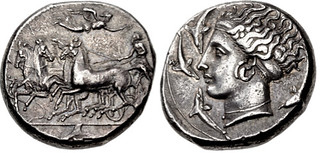
LOT 155–SICILY, Syracuse. Dionysios I. 405-367 BC. AR Tetradrachm (25.5mm, 17.22 g, 3h). In the style of Eukleidas. Struck circa 405-400 BC. Charioteer, holding kentron in right hand and reins in both, driving fast quadriga left; above, Nike flying right, crowning charioteer with wreath held in both hands; in exergue, dolphin right / Head of Arethousa left, hair in band, wearing double-loop earring and plain necklace with frontal pendant; [Σ-Y-PAK- O-ΣI-ΩN above hair], four dolphins around. Tudeer 104 (dies 35/71); HGC 2, 1345; SNG ANS 300; BMC 197; Boston MFA 444; Jameson 809; de Luynes 1208; Rizzo pl. XXXXVIII, 16 (all from the same dies). Near EF, attractive cabinet tone, reverse a touch off center. Estimated at $5,000. From the Allan Smith, M.D. Collection. Ex Gorny & Mosch 190 (11 October 2010), lot 67; Gorny & Mosch 112 (17 October 2001), lot 4036; Peter M. Suter Collection (Münzen und Medaillen AG 89, 14 June 2000), lot 83; Münzen und Medaillen AG 66 (22 October 1984), lot 43. Arguments for Daimon and for Mithraic Areimanios 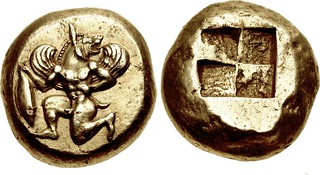
LOT 366–MYSIA, Kyzikos. Circa 550-500 BC. EL Stater (18mm, 15.87 g). Winged male mythological creature running-kneeling left, head right, holding tunny by its tail in left hand / Quadripartite incuse square. Von Fritze I 123; Greenwell 57; SNG France 271; Boston MFA 1457 = Warren 1471; SNG von Aulock 1198 = Kraay & Hirmer 704 = L. Mildenberg, “Über das Münzwesen im Reich der Achämeniden” in AMI 26 (1993), pl. VII, 62; Gulbenkian 617; Jameson 2560; Weber –. Near EF, lightly toned. Well-centered, struck from artistic dies. Very rare and exceptional for issue. Estimated at $50,000. From the LVL Collection. While the identification of this creature, certainly of local significance, is unknown today, it has traditionally been referred to as “Phobos” or “Daimon.” In his catalog of the Gulbenkian collection, Jenkins sees an Egyptian or near-Eastern influence, while Bivar, in his article on Mithra (“Mithra and Mesopotamia,” Mithraic Studies [Manchester, 1975], pp. 275-89), suggests that the creature corresponds to the Mithraic Areimanios (Ahriman). One also may see an assimilation of the ubiquitous Persian lion-headed griffin, adapting the head, wings, and tail to a human body. Although some references note the head as being that of a wolf, other examples clearly show a mane that is directly influenced by the lion heads on the common early Lydian electrum, supporting Bivar's (and others') contention that it is a lion head. At the same time, the ear is not fully visible on most examples, but on some, such as the present piece, it clearly is that of a griffin (compare to its depiction on the coins of Teos and Abdera). The wings and posture of the creature are mythological archetypes, commonly found on displays of various deities and creatures on pottery and coins. An excellent example of an archaic representation of a local deity of Asia Minor. 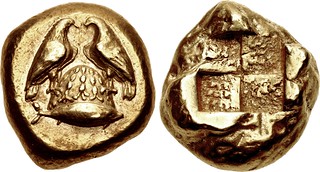
LOT 378–MYSIA, Kyzikos. 5th-4th centuries BC. EL Stater (16.5mm, 16.03 g). Two eagles standing facing each other on ornamented omphalos; below, tunny right / Quadripartite incuse square. Von Fritze I 220; Greenwell 22; SNG France 348; Boston MFA 1535 = Warren 1440. Near EF. Rare. Estimated at $20,000. From the LVL Collection. This rare type depicts the legend of the omphalos (navel) stone, which marked the sacred precinct of the sanctuary of Apollo at Delphi as the physical center of the earth. According to tradition, two eagles, which had been released by Zeus, one flying from the east, and the other from the west, met exactly at the site of Apollo's sanctuary. This spot was marked for all to see by the stone omphalos, and designated as the center of the earth. The omphalos was a white stone ornamented with stripes of various kinds, and upon it were the representations of the two eagles (as seen on this coin type – the tunny fish below is the city-badge of Kyzikos). This scene was frequently represented in vase-paintings, but is extremely rare on coinage. The omphalos probably stood on the sacred hearth that was in the center of the temple. The origins of Apollo's temple at Delphi are described in the Homeric Hymn to Apollo. Apollo descended from Mt. Olympos and made his way through northern and central Greece until he finally found the proper site for the foundation of his oracle at Crisa under the snow-capped Mt. Parnassos. He laid out his temple and then slew a she-dragon, which inhabited the area. The name of the site was subsequently called Pytho (and Apollo, the Pythian) due to the rotting body of the slain dragon. (The verb pytho, in Greek, means ‘to rot'.) Interestingly enough, Zeus punished Apollo for the murder of the dragon by exiling him to Thessaly for nine years. A religious festival called the Stepteria was celebrated every ninth year at Delphi to commemorate these events associated with the foundation myth of the sanctuary. After Apollo established his sanctuary, he went about the business of recruiting attendants for the temple. He noticed a ship passing by, manned by Cretans from Knossos, and on their way to Pylos. Apollo transformed himself into a dolphin (δελφις, hence the name of the city) and leaped aboard the Cretan ship. At first the men tried to throw the dolphin back into the sea, but they were “awed” by it into a “fearful submission”. After a lengthy voyage, Apollo led the ship to Crisa, where “he leaped ashore and revealed himself as a god amid a blaze of fiery brightness and splendor”. He ordered the Cretan men to perform sacrifices and to pray to him as Apollo Delphinius. He then led them to his sanctuary and placed the Cretans in charge, predicting great wealth and prestige for his temple. This story linked the early cult of Apollo to Crete and promoted Apollo as the god of sailors and colonization. His oracle at Delphi played a major role as the religious impetus for the Greeks in establishing their colonies, hence its importance to the residents of Kyzikos, itself a colony of Miletos. The importance of this coin type to Kyzikos may also be found in another story that has the city being settled by the Pelasgi from Thessaly, who were driven from Thessaly by the Aeolians. Their king and leader was Kyzikos, a son of Apollo, who gave his name to the city and thus established its link to Apollo and his temple at Delphi. 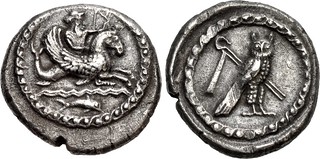
LOT 628–PHOENICIA, Tyre. Uncertain king. Circa 425-394 BC. AR Quarter Shekel (15.5mm, 2.90 g, 9h). Melkart, holding bow in extended left hand and reins in right, riding hippocamp right; below, waves above dolphin right / Owl standing right, head facing; crook and flail diagonally in background. E&E-T Group II.1.1.2; Rouvier 1789; HGC 10, 324. Near EF, toned, slight roughness, scuff on reverse. Exceptional for issue, rare in this condition. Estimated at $2,000. 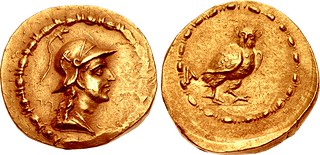
LOT 706–BAKTRIA, Indo-Greek Kingdom. Menander I Soter. Circa 155-130 BC. AV Stater (20mm, 8.57 g, 1h). Draped bust of Athena right, wearing crested helmet adorned with wing; all within bead-and- reel border / Owl standing right on ground line, head facing; A to left; all within bead-and- reel border. Bopearachchi 1A; MIG Type 211a (same obv. die as top example); SNG ANS 682; Boston MFA Supp. 312; Treasures of Ancient Bactria (Miho Museum), 46a (same dies); HGC 12, 494. EF, lightly toned, area of weak strike on obverse at periphery. Extremely rare, one of 13 specimens known. Estimated at $50,000. Unlike his silver and bronze issues, the gold coinage of Menander I Soter is very rare (as is the case with Baktrian gold issues in general). This stater, with the helmeted head of Athena on the obverse and an owl on the reverse, is among the rarest, with a total of 13 specimens known. Mitchiner questioned the authenticity of some of the specimens he recorded, but did not doubt the British Museum specimen, which is struck from the same obverse die as the present coin. Bopearachchi, in a note on the series, repeated Mitchiner's reservation without further elucidation. S. Hurter, in her review of Le portrait d'Alexandre le Grand by O. Bopearachchi and P. Flandrin in SNR 85 (2006), expressed doubt about a number of the coins in the Miho Museum and suggested that the Miho Menander (which she had not seen) should undergo further examination (pp. 190–1). 
LOT 924–Nerva. AD 96-98. AV Aureus (19mm, 7.59 g, 5h). Rome mint. Struck AD 98. IMP NERVA CAES AVG GERM P M TR P II, laureate head right / IMP II COS IIII P P, Aequitas standing facing, head left, holding scales in right hand and cradling cornucopia in left arm. Cf. RIC II 44 for type (denarius), otherwise unpublished. EF, lustrous. Unique. Estimated at $50,000. A heretofore unknown and unpublished aureus for Nerva with the reverse legend of IMP II COS IIII P P. This Aequitas type is known for a denarius (RIC II 44), but only as an aureus with the AEQVITAS AVGVST reverse inscription. For this particular issue, there are six denarii types with only three corresponding aurei types (Fortuna, priestly implements, and clasped hands with legionary aquila on prow), so it stands to reason that the three previously unlisted aurei types (Aequitas–this coin, Libertas, and clasped hands) may eventually come to light. 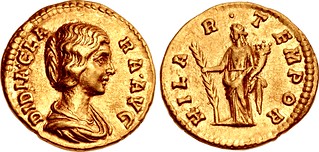
LOT 1024–Didia Clara. Augusta, AD 193. AV Aureus (20mm, 6.80 g, 12h). Rome mint. Struck under Didius Julianus. DIDIA CLA RA AVG, draped bust right / HILA R TEMPOR, Hilaritas standing left, holding in left hand a long palm frond set on ground and cradling cornucopia in right arm. RIC IV 10 (Julianus); Calicó 2402 (same obv. die as illustration); BMCRE 13 (Julianus) var. (obv. legend break); Biaggi 1053 (same obv. die); NAC 38, lot 94 (same dies); NAC 54, lot 483 (same dies). Near EF, a couple of very light scratches. Extremely rare. Estimated at $50,000. 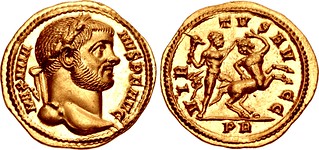
LOT 1089–Maximianus. First reign, AD 286-305. AV Aureus (19mm, 5.31 g, 6h). Rome mint. Struck AD 295-305. MAXIMIA NVS P F AVG, laureate head right / VIR TVS AV GG, Hercules standing right, leaning on hindquarters of centaur with his left knee and grasping the head of centaur with his left hand, holding upright club with his right hand, lion skin flowing behind his waist; the centaur is rearing up to the right, his head left, left hand raised in defense. RIC VI –; Depeyrot 5B/8 var. (bust draped and cuirassed); cf. Calicó 4740(obv.)/4739(rev.). Superb EF, perfectly centered. Very rare reverse type and an unpublished variety. Estimated at $50,000. 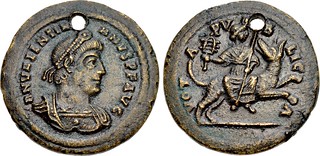
LOT 1105–Valentinian I. AD 364-375. Æ Medallion (24mm, 6.98 g, 12h). Festival of Isis commemorative. Rome mint. D N VALENTIN ANVS P F AVG, pearl- diademed and cuirassed bust right / VOT A PV B LIC A, Isis seated facing, her head right, holding sistrum with her right hand and a scepter with her left, on Sothis running right, who is looking back at her. Alföldi, Festival 90 (pl. XII, 16). Good VF, brown and tan surfaces with touches of green, holed in antiquity. Estimated at $3,000. From the estate of Thomas Bentley Cederlind. The Ptolemaic cult of Serapis and Isis enjoyed great popularity throughout Hellenistic and Roman times, and indeed the Romans, like the Greeks and Persians before them, were fascinated by the culture and monuments of ancient Egypt. The Ptolemies and the Roman emperors were not content with just being the foreign rulers of Egypt, but wanted to be viewed as legitimate successors of the Pharaohs. To this end, the Romans portrayed themselves as Pharaohs to the native population and even promoted the import of certain aspects of Egyptian culture and religion to their own native lands. The Egyptian concept of the Pharaoh as a god was appealing to the Roman emperors (the aging Julius Caesar was especially taken with this concept during his romance with Cleopatra). The Isis festival was a major celebration in Rome in the 3rd and 4th centuries, heralding the arrival of the ship of Isis (navigium Isidis) from Alexandria on 5 March. Besides Isis and Horus, other members of the Egyptian pantheon appear–Serapis, Anubis, Harpocrates, and Nilus. Such coins or tokens with imperial busts were first struck by Diocletian at Rome to mark the arrival of the ship, and the tradition continued through the 4th century; the latest imperial bust to appear is that of Valentinian II. Alföldi proposes that in the Middle Ages the festival associated with the Isis ship (also known as carrus navalis) became the car naval or carnival. Constellation of Varak/Mesha (Aries the Ram) 
LOT 1310–INDIA, Mughal Empire. Nur al-Din Muhammad Jahangir. AH 1014- 1037 / AD 1605-1627. AV Mohur (22mm, 11.86 g, 10h). Zodiac Type, Class A. Fatehpur mint. Dually dated AH 1028 and RY 14 (19 December AD 1618 – 14/23 October AD 1619). Constellation of Varak/Mesha (Aries the Ram): ram, head right, recumbent left; radiate sun behind; sanat 14 jalus (regnal year 14) in Persian below / sikka-e zar gist ba-Fatahpur faruzada nur-i nam Jahangir Shah Akbar Shah (Gold coin became lustrous at Fatehpur by the light of the name of Jahangir Shah [son of] Akbar Shah) in Persian verse; AH date in lower left. Cf. Liddle Type G-74/G- 76 (for obv./rev.) = S. Bhandare, “Important Indian coins in the Kunsthistorisches; Museum, Vienna,” in ONS Journal 205 (Autumn 2010), Fig. 7/11 (for obv./rev. – same dies as illustrations); BM –; Wright –; Hull –; Nagpur –; Lucknow –; KM 180.2 (date unlisted) and cf. 150. 3 (rupee); cf. Friedberg 762 (for type with no distinction to mint). Good VF, field marks, two shroff marks on obverse, three on reverse, with ornate suspension loop attached. Extremely rare. Estimated at $20,000. 
LOT 1571–temp. HANOVER. Charles Edward Stuart ‘Bonnie Prince Charlie'. 1720-1788. AV Medal (52mm, 74.55 g, 12h). Legitimacy of the Jacobite Succession. By T. Pingo. A later strike from dies made c. 1750. PRINCE CHARLES EDWARD STUART, bare head right / Charles in highland dress standing left, extending hand to Scotia standing right, holding spear and resting hand on shield; cornucopia on ground between; to left, Unicorn seated right on plinth; castle and ships in background; SEMPER ARMIS NUNC/ ET INDUSTRIA (Always with arms and now with diligence). Woolf 64.1 (unlisted in gold); Eimer, Pingo 6; MI 656/360 (unlisted in gold); Eimer 626. Choice EF, light die rust on reverse as usual. Considerable luster. Extremely rare in Gold. Includes old collection ticket. Estimated at $10,000. Ex Property of a Gentleman (Sotheby's New York, 8 December 1992), lot 193, purchased from I. Snyderman (Art Trading Company), 16 January 1959; J. Pierpont Morgan Collection; reportedly also ex Thomas Fortune Ryan Collection. Printed catalogs for CNG 102 are now available. To order the catalog, please call our U.S. office at (717) 390-9194. Catalogs have been mailed to customers on CNG's active mailing list. Prospective bidders may also view the virtual catalogs at CNG 102 Virtual Catalog. The sale can be viewed online at cngcoins.com, sixbid.com and numisbids.com. In addition to Internet & Mail Bid Sale 102, CNG will also feature over 850 lots from many of the same collections listed above in their Electronic Auction 375, closing two weeks later on Wednesday, June 1, 2016, from 10AM ET (U.S.). Bidding for CNG Electronic Auction 375 will begin on May 11, 2016. CNG is currently accepting consignments for future auctions sales. Please contact the firm for further details and consignment deadlines. For further details and any additional information, please contact CNG, Inc. at: Classical Numismatic Group, Inc.

Wayne Homren, Editor The Numismatic Bibliomania Society is a non-profit organization promoting numismatic literature. See our web site at coinbooks.org. To submit items for publication in The E-Sylum, write to the Editor at this address: whomren@gmail.com To subscribe go to: https://my.binhost.com/lists/listinfo/esylum All Rights Reserved. NBS Home Page Contact the NBS webmaster 
|